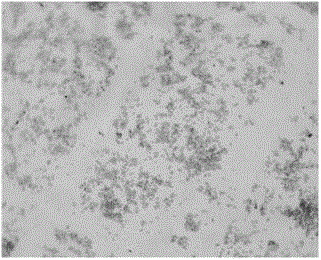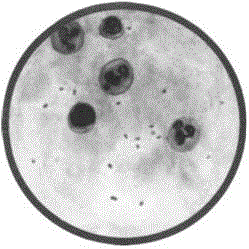16S rDNA based preparation method of bacteria nucleic acid fingerprint characteristic spectrums and application thereof
A fingerprint feature and bacterial nucleic acid technology, applied in the biological field, can solve the problems of easy introduction of errors, easy generation of sets of peaks in sequencing, and high cost.
- Summary
- Abstract
- Description
- Claims
- Application Information
AI Technical Summary
Problems solved by technology
Method used
Image
Examples
Embodiment 1
[0111] Example 1. The establishment of a single bacterial nucleic acid fingerprint feature map
[0112] 1. Design and select universal primers
[0113] According to the conserved region (SEQ ID No: 3) of the 16S rDNA of Listeria monocytogenes (Listeria monocytogenes EGD-e, NCBI accession number: NC_003210.1), the general PCR primers were designed, respectively:
[0114] 5-aggaagagagAGAGTTTGATCCTGGCTCAG-3 (SEQ ID No: 1)
[0115] 5-cagtaatacgactcactatagggagaaggctCTGCTGCGTCCCGTAG-3 (SEQ ID No: 2)
[0116] Among them, the sequences AGAGTTTGATCCTGGCTCAG and CTGCTGCGTCCCGTAG respectively match the 16S rDNA region to be amplified, and aggaagagag and cagtaatacgactcactatagggagaaggct are additional sequences added to the upstream and downstream PCR primers to ensure that in order to transcribe the PCR product, the 5' end of the primer of SEQ ID No: 1 contains 10bp The tag (aggaagagag), the 5' end of the primer of SEQ ID No: 2 contains a 31bp tag (cagtaatacgactcactatagggagaaggct).
[...
Embodiment 2
[0161] Example 2, small-scale verification of the preparation method of the nucleic acid fingerprint characteristic map of implementation 1
[0162] Using the method and primers described in Example 1, Acetobacter pasteurianus IFO 3283-01 and Azorhizobium caulinodans ORS 571 chromosome were digested and identified by mass spectrometry.
[0163] Repeat twice to get the same nucleic acid fingerprint feature spectrum, where figure 2 , image 3 The nucleic acid fingerprint characteristic maps of Acetobacter and nitrogen-fixing rhizobia are shown respectively.
Embodiment 3
[0164] Embodiment 3, the establishment of the nucleic acid fingerprint feature map library of bacteria
[0165] According to the method and primers described in Example 1, the bacteria listed in Table 1 were digested and identified by mass spectrometry, and the nucleic acid fingerprints of all bacteria were obtained.
[0166] These feature maps are integrated and analyzed by Bioexplore software to obtain a nucleic acid fingerprint feature map library including most bacteria.
[0167] As shown in table 2, Figure 4 - Figure 100 The nucleic acid fingerprint feature maps of 97 kinds of bacteria are displayed respectively.
[0168]
[0169]
[0170] Table 2 (Note: Table 2 is the content in italics in Table 1)
[0171] Figures 101-103 It is the nucleic acid fingerprint characteristic map of sheep, cattle, and suis Brucella, Figure 104 It is the nucleic acid fingerprint characteristic map of Mycobacterium tuberculosis, Figure 105 It is the nucleic acid fingerprint char...
PUM
| Property | Measurement | Unit |
|---|---|---|
| Diameter | aaaaa | aaaaa |
Abstract
Description
Claims
Application Information
 Login to View More
Login to View More - R&D
- Intellectual Property
- Life Sciences
- Materials
- Tech Scout
- Unparalleled Data Quality
- Higher Quality Content
- 60% Fewer Hallucinations
Browse by: Latest US Patents, China's latest patents, Technical Efficacy Thesaurus, Application Domain, Technology Topic, Popular Technical Reports.
© 2025 PatSnap. All rights reserved.Legal|Privacy policy|Modern Slavery Act Transparency Statement|Sitemap|About US| Contact US: help@patsnap.com



